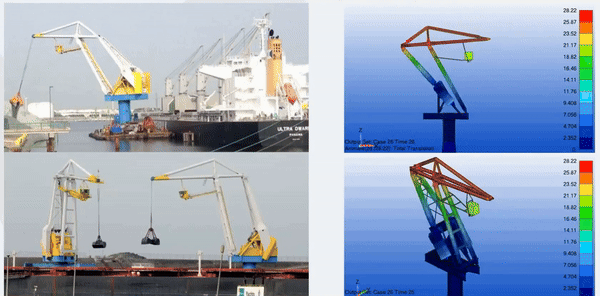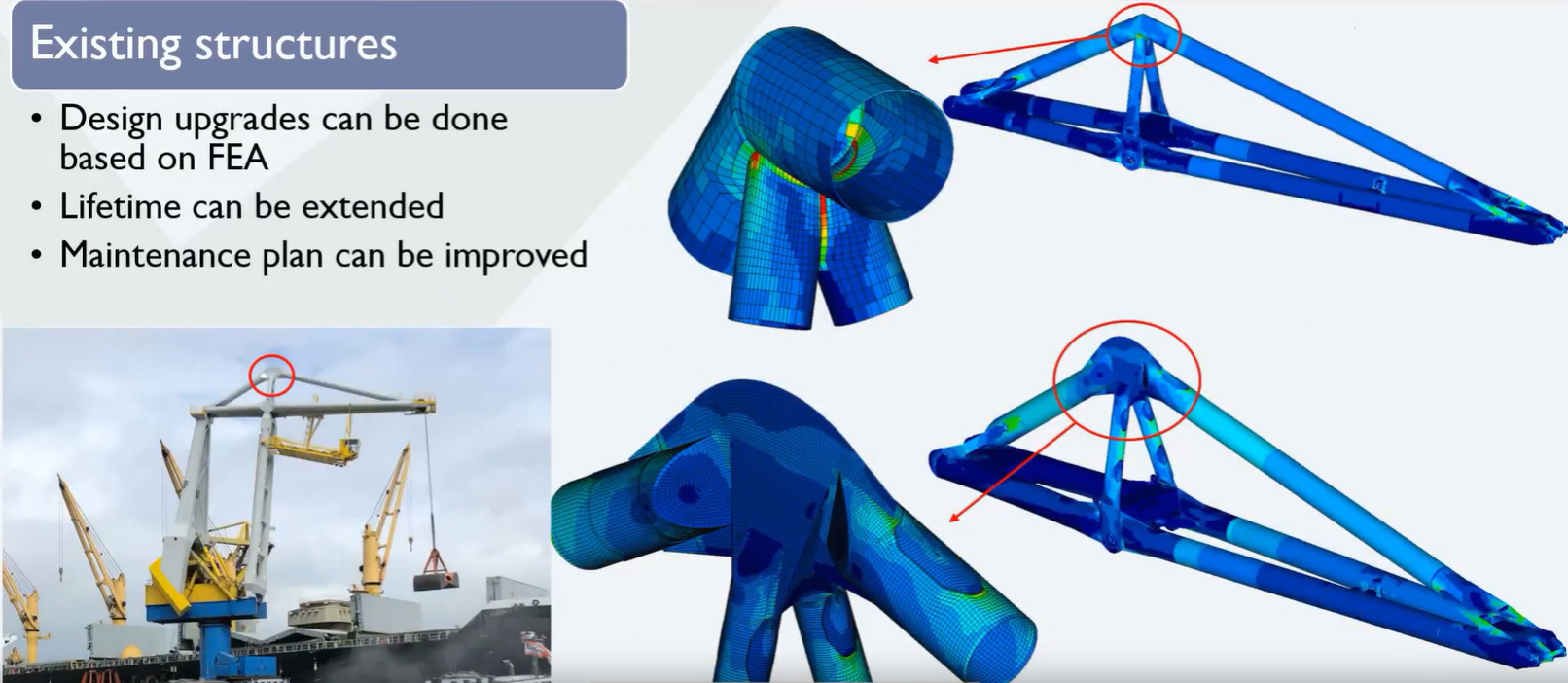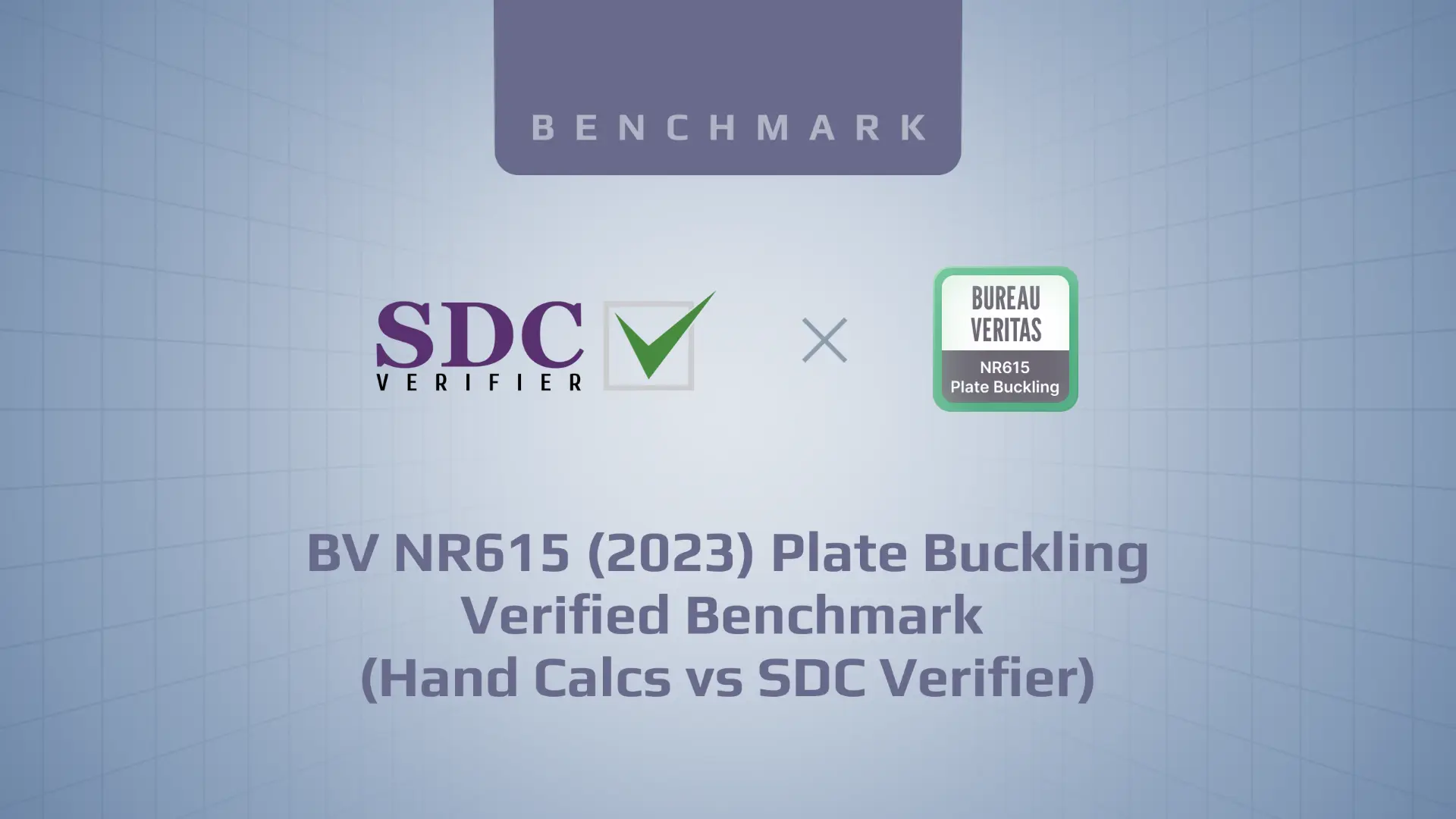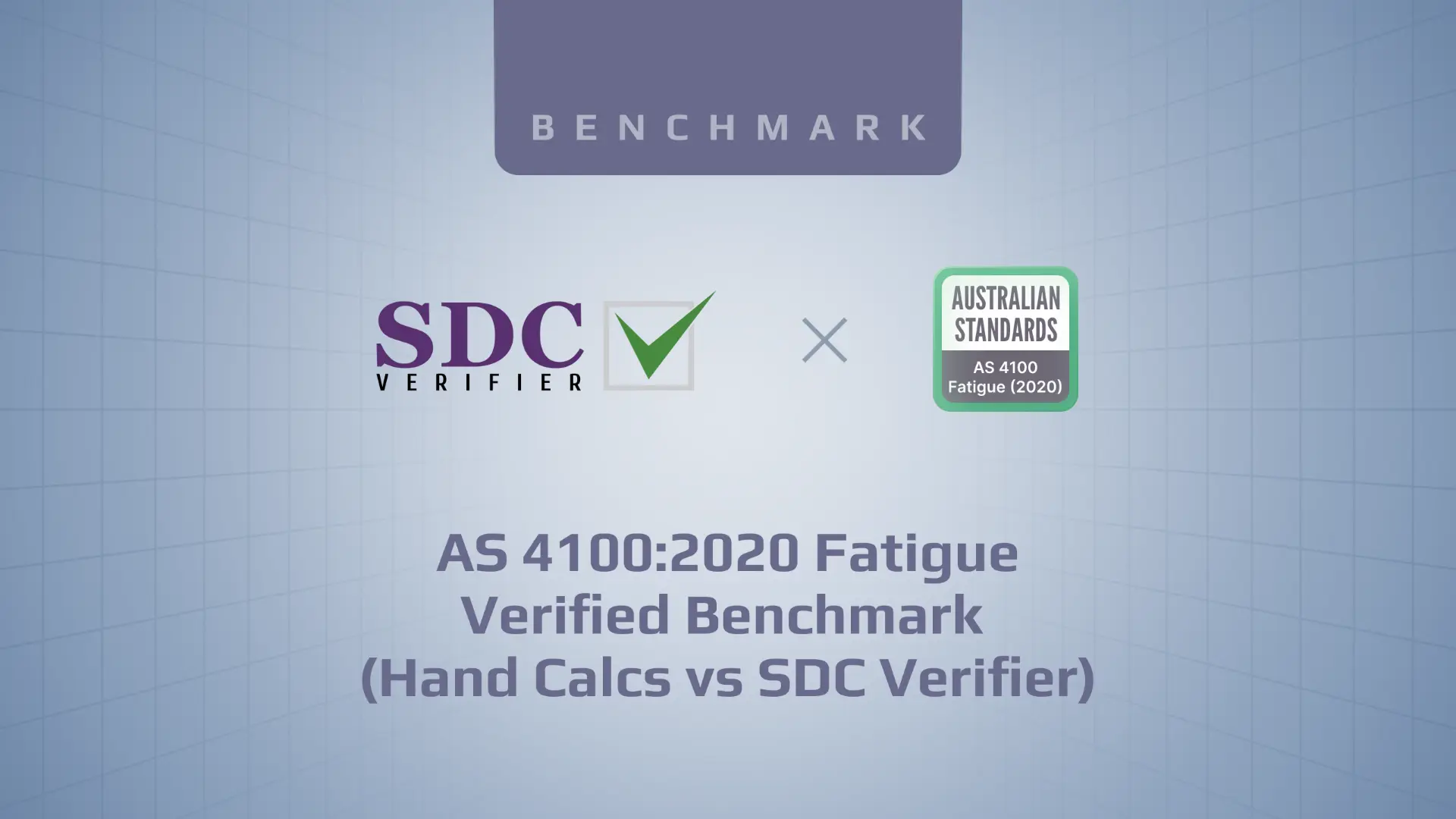How to Stop Costly Port Equipment Downtime? Revolutionize Maintenance with FEA
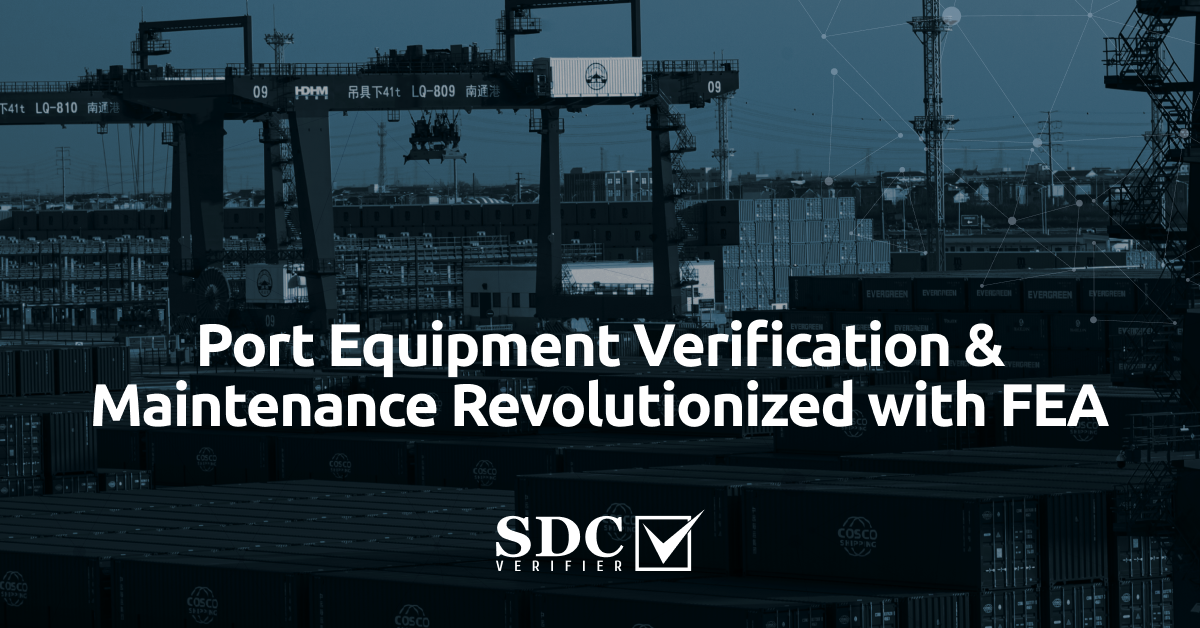
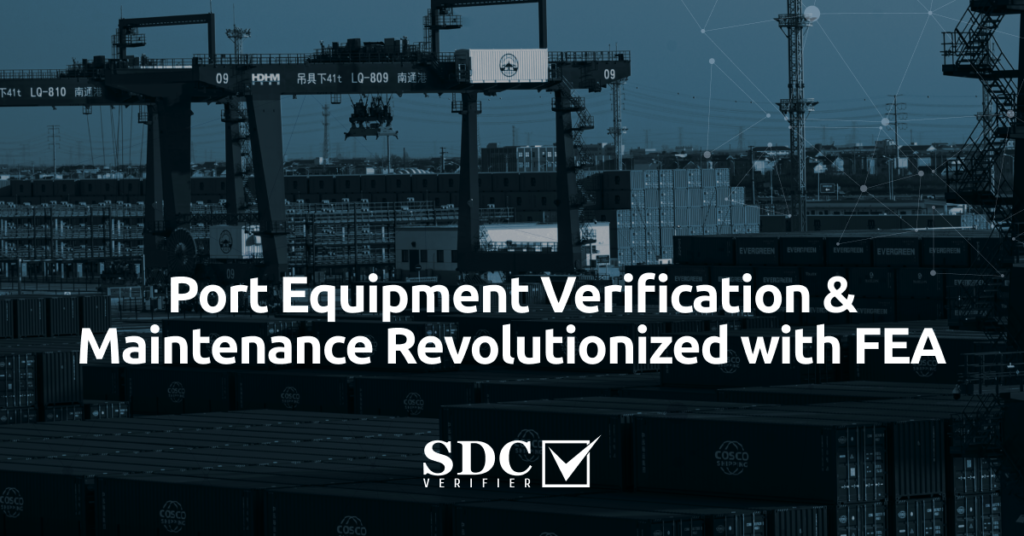
Traditional verification methods, often reliant on outdated standards and hand calculations, struggle to keep pace with the demands of modern cranes.
This article explores how Finite Element Analysis (FEA), coupled with structure software SDC Verifier, can revolutionize port equipment verification and maintenance workflows.
Challenges of Traditional Port Equipment Verification
Many port cranes, the workhorses of modern container terminals, were designed using older engineering standards (DIN 15018, NEN, FEM) that may not fully capture the complexities of today’s behemoth equipment.
Cranes designed using older standards may not account for the increased weight and stresses imposed by modern container vessels.
Traditional methods often rely on conservative assumptions to compensate for a lack of detailed analysis. This can lead to:
- The inability to accurately predict remaining operational life creates uncertainty about future maintenance needs.
- Difficulty in pinpointing critical areas necessitates more frequent, broad inspections, increasing downtime and maintenance costs.
- Reliance on hand calculations hinders the identification of potential failures, raising safety concerns.
Benefits of Finite Element Analysis (FEA) for Port Cranes
By meticulously simulating structures, FEA software delivers a wealth of detailed data, including stress, displacement, and internal force information for every location within the crane model. This empowers engineers to:
- Perform Comprehensive Verification. Analyze structures under a wide range of loading scenarios, encompassing not only typical operating conditions but also worst-case eventualities.
- Gain Full Control Over the Structure’s Lifespan. By predicting fatigue damage accumulation at critical locations, FEA allows for proactive maintenance strategies. Engineers can pinpoint areas susceptible to fatigue cracks before they become a safety hazard, maximizing the operational life of the equipment.
- Optimize Designs. FEA, with its detailed analysis capabilities, facilitates the creation of lighter and more efficient structures. This translates to reduced material usage, lower construction costs, and potentially improved fuel efficiency during crane operation.
- Reduce Inspection Frequency: Traditional methods, lacking the precision of FEA, often necessitate frequent and broad inspections to compensate for a lack of detailed information. FEA-based targeted inspections significantly reduce downtime and associated maintenance costs.
- Extend Equipment Lifespan: Proactive maintenance strategies informed by FEA analysis enable engineers to address potential issues before they escalate into major failures. This proactive approach significantly extends the operational life of cranes, maximizing return on investment for port authorities.
Role of FEA in the Expanding Landscape of Cranes
Here, Finite Element Analysis (FEA) emerges as an indispensable tool, enabling engineers to confidently verify the impact of such modifications on critical aspects of crane performance:
- Strength
FEA meticulously analyzes the structure under the increased loads imposed by larger vessels, ensuring the crane can handle these demands without compromising safety.
- Buckling
By simulating the behavior of the modified structure, FEA helps assess the risk of buckling under the new loading conditions. This allows engineers to identify potential weak points and implement necessary reinforcements.
- Fatigue Life
Modifications can introduce new stress patterns and potentially impact the remaining operational life of the crane. FEA analysis predicts fatigue damage accumulation, allowing engineers to assess the impact of modifications and plan for future maintenance needs.
The illustration showcases a fatigue crack (F) on a welded joint of a crane beam. This type of damage is a critical concern in port equipment due to the repeated loading cycles experienced during operation. Finite Element Analysis (FEA) can be employed to predict stress concentrations at weld toes, thereby identifying locations susceptible to fatigue crack initiation and propagation. Early detection of such cracks through FEA analysis allows for timely intervention, such as weld repairs or preventative maintenance strategies, ensuring structural integrity and operational safety.
- Connections
Existing connections may not be adequate to handle the increased loads associated with modifications. FEA verifies the adequacy of these connections, ensuring they can safely transfer the forces without failure.
- Stiffness
Maintaining operational efficiency is crucial. FEA analysis helps assess the impact of modifications on the crane’s stiffness under new configurations. This ensures the crane can operate smoothly and precisely during cargo handling.
FEA offers a significant advantage over methods that rely on simplified 1D elements.
By creating a detailed digital model of the crane and incorporating the specific modifications, FEA provides a highly accurate and realistic assessment of the structure’s behavior, fostering confident decision-making for port authorities.
This versatile technology offers a range of valuable applications throughout the lifecycle of port equipment.
|
Application |
Description |
Benefit |
|
Verifying Modifications |
Assess impact of boom adjustments, increased rail span, load capacity upgrades, or component replacements |
Ensures safety and integrity of equipment |
|
Safeguarding Crane Transportation |
Analyze local stress concentrations and support issues during transport |
Minimizes risk of damage during relocation |
|
Assessing Crane Relocation |
Evaluate influence of wind zone changes on stability, wheels/rails, and overall structural strength |
Ensures safe and efficient operation in new location |
|
Safe Dismantling & Decommissioning |
Develop safe dismantling plan considering shifting center of gravity and uneven load distribution |
Minimizes risks to personnel and property |
SDC Verifier: A Comprehensive Solution for Streamlined Workflows
While FEA offers a powerful toolbox for port equipment verification and maintenance, harnessing its full potential comes with its own set of challenges. Additionally, ensuring compliance with a multitude of industry standards, such as FEM, Eurocode, EN 13001, DIN, DNV GL, and FKM, adds another layer of complexity to the FEA workflow.
Standalone software as SDC Verifier, offer a comprehensive solution by combining FEA analysis with code checking capabilities within a single platform.
This eliminates the need to switch between separate tools for analysis and code verification, saving valuable engineering time and simplifying the workflow.
With everything housed in a single user-friendly interface, engineers can seamlessly progress from detailed structural analysis to confident code compliance checks, all within the same software environment.
Weld Fatigue Assessment with SDC Verifier
While traditional methods have served their purpose, they present significant obstacles in the modern world of port equipment maintenance. Here’s a closer look at the challenges engineers face:
- Time-Consuming Calculations: Relying on hand calculations and spreadsheets slows down the process and increases the risk of errors.
- Coordinate System Labyrinth: Transforming stress data from local weld reference frames to a global coordinate system for analysis is complex and error-prone.
- Manual Weld Classification: Assigning classifications for large models is a tedious manual task, prone to human error and inefficiency.
SDC Verifier tackles these challenges head-on, offering a suite of features that streamline and enhance weld fatigue assessment:
- Automatic Weld Classification: This powerful feature automates the classification process based on model data and user-defined parameters, eliminating the need for manual classification and saving valuable engineering time.
- Local Stress Direction Awareness: SDC Verifier leverages detailed stress data directly from the FEA analysis. This data considers the local stress directions at each weld location, leading to more accurate and realistic fatigue assessments.
- Real-World Usage Integration: Traditional methods often rely on worst-case scenarios, which may not reflect the actual usage patterns of the crane. SDC Verifier allows engineers to incorporate real-world usage data into the assessment, resulting in more realistic fatigue life predictions that optimize maintenance planning.
The software offers robust support for a wide range of industry standards, including:
With SDC Verifier, engineers can be assured that their assessments adhere to the relevant regulatory requirements. Furthermore, the software takes transparency to the next level. All the formulas employed for code checks are readily accessible and editable by the user.
This fosters trust in the results and allows for project-specific adjustments, ensuring a perfect balance between code compliance and optimal design considerations.
Presenting Insights and Optimizing Designs
SDC Verifier empowers engineers on both these fronts:
- Clear Visualization: The software presents complex analysis results in a user-friendly format, utilizing clear plots and tables. This facilitates easy interpretation of the data and fosters seamless communication between engineers, maintenance personnel, and decision-makers.
- Design Optimization Tools: Beyond analysis, SDC Verifier offers a suite of built-in design optimization tools. These tools empower engineers to identify the most efficient solutions for beams, plates, and welds. This translates to lighter and more cost-effective designs, optimizing material usage and minimizing overall project costs.
Project Management with SDC Verifier
- Customized Reporting Made Easy: Gone are the days of tedious report generation. SDC Verifier’s user-friendly interface allows engineers to create customized reports tailored to specific project needs using a drag-and-drop functionality. This streamlines communication and ensures all stakeholders have access to the most relevant information.
- Seamless Sharing and Archiving: The software facilitates effortless sharing and archiving of reports. Reports can be exported to various formats, including Word and PDF, while maintaining automatic navigation for easy reference. This ensures critical project information remains readily accessible for future use.
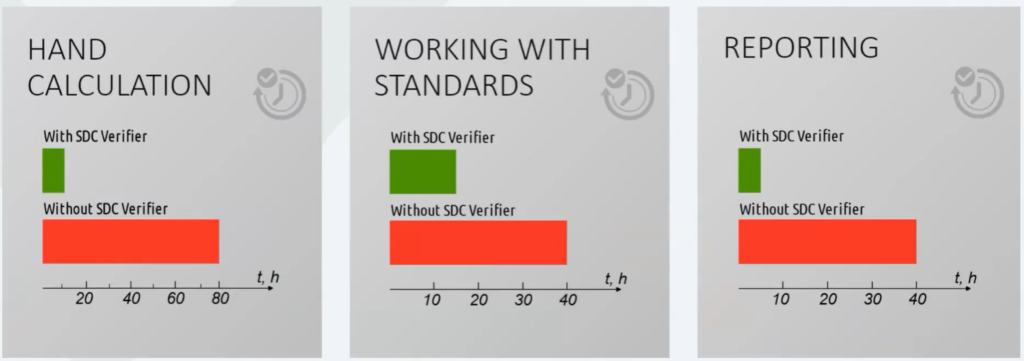
In essence, SDC Verifier offers a compelling proposition for port authorities seeking to revolutionize their equipment management practices. It unlocks a new era of efficiency, accuracy, and streamlined workflows, ultimately safeguarding the safety and longevity of critical port infrastructure.



